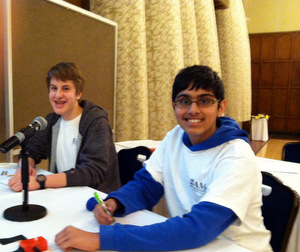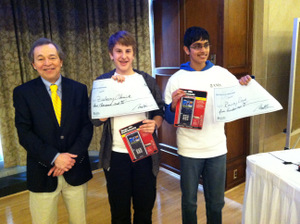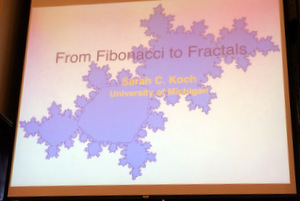
Who Wants to Be a Mathematician at the University of Michigan
"It was a fun day for all of us."
"My students that attended the event came into my classroom at the end of the day and were all talking at once as they were so excited to share about their time spent at Who Wants to be a Mathematician. They thoroughly enjoyed the lecture and the game."
On March 6, the University of Michigan Department of Mathematics hosted a morning of mathematics on the campus in Ann Arbor with a talk by faculty member Sarah C. Koch followed by Who Wants to Be a Mathematician. The big winner in the game was Zachary Obsniuk, a junior at Churchill High School, who won $3,000.
From Fibonacci to Fractals, Sarah C. Koch, University of Michigan
|
(Right: Chair Mel Hochster welcomes the crowd.) |

|
 |
Koch (left) give a nice lecture on the connection between the Fibonacci sequence and fractals. She started by explaining the sequence and its relevance to the golden ratio, noting that the sequence and ratio are ubiquitous, cropping up in many arrangements, for example in seashells and sunflower seeds.
|
Koch then introduced the Mandelbrot set, first by examining repeated iterations of functions at points in the complex plane. Points that did not go to infinity as the number of iterates increased were colored black. She focused on one particular family of functions, f(z) = z2 + c, and asked how the picture changed for different values of c.
 |
The Mandelbrot set is the set of all c in the complex plane such that the sequence (c, c2 + c, (c2 + c)2 + c, ...) does not go to infinity--that is, is bounded. The surprising connection between the Mandelbrot set, from dynamics, and the Fibonacci sequence, from discrete math, is in the small protruberances (bulbs) of the set.
|
 |
For example, consider c = -1. If we iterate z2 - 1 starting at 0 we get -1, 0, -1, 0, ... , that is, a repeating cycle of length 2. The number -1 is the center of the bulb at the far left. Points at the center of the bulbs have cycles of different lengths. Given two bulbs associated with cycles of length a and b, the largest bulb between them is centered at a point with a cycle of length a + b. This recursive summing property is how the Fibonacci sequence is defined. Furthermore, one can look at the points in a cycle and observe in what order those points are generated (moving counterclockwise) when iterating z2 + c. In this way, a rational number can be associated with each bulb (some are pictured at left). The denominator of the bulb is the length of the cyle and the numerator is the distance geometrically between successive iterates. Surprisingly, for two bulbs associated with rational numbers m/a and n/b, respectively, the largest bulb in between will have as its rational number the Farey sum of those numbers: (m+n)/(a+b). |
The audience was very engaged by Koch's lecture, answering questions she posed throughout the lecture and asking questions themselves afterwards.
Slideshow of the lecture and game:
Created with flickr slideshow.
Who Wants to Be a Mathematician
Following the lecture and a break featuring sumptuous treats, eight local students played Who Wants to Be a Mathematician.
 |
Left to right: Sarah C. Koch, Morgan Borjigin-Wang, Skyline High School; Marianne Cowherd, Community High School; Quang Le, Rudolf Steiner High School; Raviraj Rege, Indus Center for Academic Excellence (ICAE) and Novi High School; Zachary Obsniuk, ICAE and Churchill High School; Carissa Skye, Dexter High School; Sanelma Heinonen, Pioneer High School; Abbey Stepnitz, Pioneer High School; and Mel Hochster.
|
Here are videos from that day, followed by descriptions of each game, the Square-Off and Bonus:
The early leaders in both games wound up winning their games. Raviraj was the wire-to-wire leader in game one. Carissa, Morgan, and Sanelma took turns in second place in the last three questions with Morgan claiming second at the end of that game. Two hundred points separated the three contestants at the end of game one. In game two, it was Zachary who led the whole way, followed by Quang, Abbey and Marianne.
 |
Raviraj and Zachary each won $500 and a TI-Nspire CX for winning their games and then squared off for a chance at the $2,000 Bonus Question. Zachary won the Square-Off to up his cash total to $1,000 and advance to the Bonus Round, which was a question about the roots of polynomials. He was all over it, answering correctly and giving a wonderful explanation, which brought his grand total for the day to $3,000 and the TI-Nspire CX.
|

Here are all the prizes and cash won by the contestants:
- TI-Nspire CX graphing caclulator from Texas Instruments and $3,000 from the AMS: Zachary Obsniuk, Indus Center for Academic Excellence and Churchill High School
- TI-Nspire CX graphing calculator from Texas Instruments and $500 from the AMS: Raviraj Rege, Indus Center for Academic Excellence and Novi High School
- Maple 2015 from Maplesoft: Morgan Borjigin-Wang, Skyline High School and Quang Le, Rudolf Steiner High School
- Calculus with Early Transcendentals by Anton, Bivens and Davis from John Wiley and Sons: Abbey Stepnitz, Pioneer High School and Carissa Skye, Dexter High School
- What's Happening in the Mathematical Sciences, Vol. 9: Sanelma Heinonen, Pioneer High School and Marianne Cowherd, Community High School
Thanks very much to our sponsors: Maplesoft, the Who Wants to Be a Mathematician technology sponsor, Texas Instruments, and John Wiley and Sons. Thanks also to Michael Jones and Norman Richert of Math Reviews and to Stephen DeBacker of the University of Michigan Department of Mathematics for their help arranging the logistics for the lecture and the game (and the refreshments).
Photos by Norman Richert, Michael Jones, Bill Butterworth (DePaul University), co-creator of and judge for Who Wants to Be a Mathematician, and Mike Breen (AMS), co-creator and host of Who Wants to Be a Mathematician. Videos by Bill Butterworth. Text by Mike Breen.
Find out more about Who Wants to Be a Mathematician .


